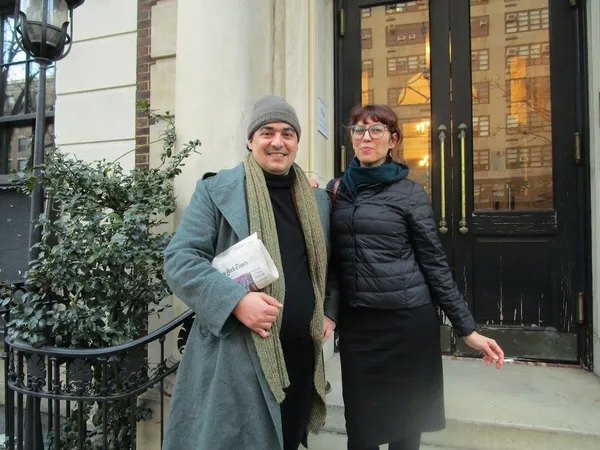 |
| Claudia Squitieri with Manuel Maria Perrone at the Italian Cultural Institute book launch for Claudia Cardinale. L’indomabile. The Indomitable (Cinecittà and Electa Editore) Photo: Anne-Katrin Titze |
Luigi Comencini's La Ragazza Di Bube (Bebo’s Girl, 1963) opened Cinecittà and the Museum of Modern Art’s retrospective celebrating Claudia Cardinale on Friday. Pietro Germi’s Un Maledetto Imbroglio (The Facts Of Murder, 1959); Mauro Bolognini’s Il Bell’Antonio (Handsome Antonio, 1960), La Viaccia (The Lovemakers, 1962), and Senilità (Careless, 1962); Valerio Zurlini’s La Ragazza Con La Valigia (Girl With A Suitcase, 1961); Luchino Visconti’s Rocco E I Suoi Fratelli (Rocco And His Brothers, 1960), Il Gattopardo (The Leopard, 1963) Sandra (1965); Federico Fellini’s Otto E Mezzo (8 1⁄2, 1963); Sergio Leone’s Once Upon A Time In The West (1968); Marco Bellocchio’s Enrico IV (Henry IV, 1984); Pasquale Squitieri’s Atto Di Dolore (1990), and Manoel de Oliveira’s O Gebo E A Sombra (Gebo And The Shadow, 2012) are some of the many highlights.
In the first instalment with Claudia Squitieri we discuss many of the films her mother Claudia Cardinale starred in; Oscar-awarded costume designers Piero Tosi (honoured in 2014, accepted by Cardinale) and Milena Canonero (Stanley Kubrick’s Barry Lyndon; Hugh Hudson’s Chariots Of Fire; Sofia Coppola’s Marie Antoinette; Wes Anderson’s The Grand Budapest Hotel); Franco Cristaldi’s production company; Fondazione Claudia Cardinale - Fondation CC, and her role as the curator of the book Claudia Cardinale. L’indomabile. The Indomitable (Cinecittà and Electa Editore).
From Paris, Claudia Squitieri joined me on Zoom for the start of an in-depth conversation on the life and career of Claudia Cardinale, who is a UNESCO Goodwill Ambassador and supporter of Green Cross Italy and Amnesty International.
Anne-Katrin Titze: Hello Claudia! You are in Paris?
Claudia Squitieri: Hello, yes! And I’m rushing because I’m going to the countryside where I live with my mother. I kind of juggle between Paris, where I have my child, and outside Paris where we are creating this foundation and a big project; it’s next to Fontainebleau, the Fontainebleau Forest.
AKT: What is the foundation called?
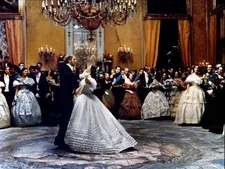 |
| Claudia Cardinale as Angelica dancing with Prince Don Fabrizio Salina (Burt Lancaster) in Luchino Visconti’s The Leopard |
CS: It’s simply Fondazione Claudia Cardinale - Fondation CC. My mother, you know, has been for many years a UNESCO Goodwill Ambassador for the rights of women and young girls. She’s done a lot of battles in her life. She’s been with Amnesty International against death penalty and she’s also been with the Green Cross for the Environment and the idea has come up in the last couple of years. I’ve always been close to my mother, but for some years we’ve got even closer and it was the idea to create this foundation to pursue her engagements.
Now she can’t really travel around the world like she used to. She’s 84, so the idea was concrete projects would take over in some way. I come from the art history world and contemporary art world so the idea was to pursue addressing such issues, like the environment and rights of women, which obviously touches me very directly in many ways, so we’re working with our partners, Green Cross Italy and UNESCO to continue doing that.
AKT: Sounds fantastic. How is your mother doing?
CS: She is doing great, we’ve been to Italy not long ago for the presentation of the book and she was absolutely delighted to be back in Italy. It’s been quite some time, as you can imagine with Covid and all the rest of things, traveling past a certain age has become a little bit more tricky. So she was delighted and all the team from Cinecittà are wonderful people. So besides being very honoured she also had a lot of fun.
AKT: The series at MoMA sounds great. One of my favourites, Visconti’s The Leopard, will be a part of it. It’s been a little while since I’ve seen it, but in my memory, her costumes are very present. And her hairstyle. During the scene with the laugh, her up-do is partly braided and has a kind of messy quality to it that could make you think of Medusa.
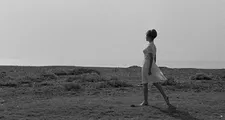 |
| Claudia Cardinale in Federico Fellini’s 8 1/2 |
CS: Yes, very! You know, Visconti was so obsessive in a way, he didn’t want her to wash her hair too much. Because women of that time, they wouldn’t wash their hair as much as later generations would. And my mother was shooting 8 1/2 by Fellini at the same time as she was shooting with Visconti. So Visconti wanted her hair very dark and not washed too much and Fellini wanted her light coloured hair, so she was dying her hair every other week. It was an incredible experience for her to do, to have such opposites at the same time.
AKT: What a great story.
CS: And the laugh - René de Ceccatty mentions it in the book - it wasn’t in Lampedusa. He doesn’t speak about that laughter, which is very interesting because it must have been really something that she created as an actress and with Visconti. She was very close to Visconti and Visconti was actually very tender to her, which was quite unusual because he wasn’t an easy man.
He was a man of quite an aura and very cultured obviously. But he had her in his good books, he adored her and called her Claudine. My mother was very fond of Visconti, to the point that when he did Gruppo Di Famiglia In Un Interno [Conversation Piece] he wanted her to just do an appearance and she appears as his the professor’s [Burt Lancaster] wife.
AKT: I love that film.
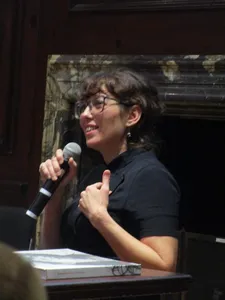 |
| Claudia Squitieri at the Italian Cultural Institute Photo: Anne-Katrin Titze |
CS: You were speaking about the costumes in The Leopard. That was Piero Tosi, he had the Oscar not long ago and my mother actually went to accept it for him. He was very old. He was an artist of his own category! My mother shot a couple of films with him, among them La Viaccia, which has also incredible costumes. He was an incredible artisan and creator. During the shooting of Il Gattopardo my mother’s corsets were so tight that one day Visconti, or even Piero Tosi went up to her and realised that she was bleeding. She had blood and real injuries and my mother was like “It’s not me, it’s Angelica.”
AKT: Wow!
CS: She had that capacity of being very professional. She would never stop such a big film for her own discomfort. It was very difficult to shoot; they were shooting with all those costumes in the summer and they were dying of heat. It was really difficult when you’re not used to being dressed like that.
AKT: Even then, history tells us now how women were suffering in these corsets every day in the19th century and earlier. The beautiful white dress in the dancing scene makes you forget all that.
CS: Yes, it’s beautiful.
AKT: You mentioned the Bolognini film. There is a scene where your mother and another actress walk across a piazza in Florence and their walk and dresses make them almost resemble elegant horses.
CS: It’s incredible, those black dresses! That’s Piero Tosi as well, with the little umbrellas! He was a magician and it helped. My mother used to say and she still does, you know, to get into a role costumes are so important. That kind of work is just so vital. And in Italy we’ve had great examples, even after Piero Tosi. There’s Milena Canonero, she has the Oscar as well. She did the Kubrick films. We have a big tradition Italy of that.
AKT: In La Viaccia her character also has a shawl that looks like a net she wraps around herself, as though she were a fish caught in it. I remember your mother on the poster at Cannes in 2017.
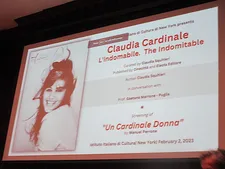 |
| Claudia Cardinale. L’indomabile. The Indomitable Photo: Anne-Katrin Titze |
CS: Yes, it was the 70th.
AKT: A word about the book [Claudia Cardinale. L’indomabile. The Indomitable]! You are launching it in New York this week! I will see you there!
CS: Yes, we’re presenting it at the Italian Cultural Institute. I wasn’t expecting to curate the volume, I was extremely honoured that Cinecittà chose to give me such a task. It was an absolute pleasure to do with Cinecittà and Electa Editore. It was a great opportunity for me to reflect upon my mother’s career, her life, and to try and find a way that everything sort of gathers. That’s why the theme of “indomabilità” came out. I had the pleasure to choose the people who contributed.
Some are friends who’ve known my mother since always and others were more university professors who were doing great studies on Franco Cristaldi’s production company [Cristaldifilm]. I had read their book, so I was interested to collaborate with them. This “indomabilità” is really what gathers together my mother’s life in a big way, through her roles, her women’s choices, the battles she’s had. I think it’s very fitting. The further we went with the publication, the more I was realising how fitting it was. The Indomitable.
AKT: Lovely to meet you!
CS: Ciao ciao, thank you very much, see you in New York.
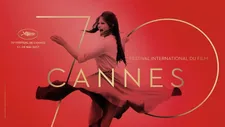 |
| Claudia Cardinale on the 2017 Cannes Film Festival poster |
Coming up - Claudia Squitieri on Werner Herzog, Klaus Kinski, Mick Jagger, Jason Robards, Thomas Mauch, and filming Fitzcarraldo, encountering Fernando Trueba in Deauville, reconnecting with Jean Rochefort, Manoel de Oliveira and an “atmosphere of mysticality” during the making of Gebo and the Shadow, plus Pink Panthers, the problem with sequels and playing Roberto Benigni’s mother.
“Claudia Cardinale” runs through Tuesday, February 21 and is produced by Cinecittà and the Department of Film, the Museum of Modern Art in collaboration with the Italian Cultural Institute. The retrospective has been organised by Paola Ruggiero and Camilla Cormanni, Cinecittà and Joshua Siegel, Curator, Department of Film, The Museum of Modern Art. Thanks to Claudia Squitieri and Fabio Finotti, Director of the Italian Cultural Institute in New York.






















